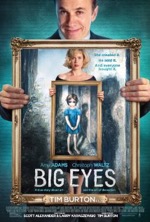Big Eyes (PG-13)
10/01/15 22:22 Filed in: 2014

Starring: Amy Adams
December 2014
This review was originally tweeted in Real-time from the back row of a movie theater and appears @BackRoweReviews. Though efforts were made to tease rather than ruin this movie’s memorable lines and moments, some spoilers may exist in the following evaluation. The original tweets appear in black, while follow-up comments appear in red. For concerns over objectionable content, please first refer to one of the many parental movie guide websites. All ratings are based on a four star system. Happy reading!

No Johnny Depp? No Helena Bonham Carter? Boy, Burton really is turning over a new leaf.
“You’re better than spare change.” Quite a pick up line.
It’s on the opposite end of the spectrum from “You look like a million bucks!”
“You are on the threshold of untold success.” Something tells me Adams’ fortune is about to come true.
Of course, I’ve seen the trailer, so I cheated.
The “Hobo Kids” paintings are all the rage thanks to the altercation reported on the front page.
A surefire way to create a sensation is to couch it in controversy.
Charging for posters of paintings...what a concept.
It was revolutionary for its time, but would be an obvious move by modern marketing (which, of course, would utilize the internet to drive sales).
The grocery store scene is the first traditional Burton flourish in the film.
This scene might weird some people out, but it’s really telling of Adams’ character’s psyche. On the other hand, maybe she’s completely sane and that particular store just happened to be invaded by aliens hailing from the same world as that big eyed nurse seen at the beginning of Star Trek (2009).
S. Cenic. The cat’s out of the bag.
“Scenic” is such an obvious tipoff that I’m surprised nobody in the art world caught it and ousted Walter Keane on the spot…unless this was artistic license taken by Burton in order to preserve the anonymity of the not-so-innocent artist/huckster until late in the film.
Adams works on a “defining statement” for the World’s Fair.
One set of big eyes per painting is manageable, but a throng of such bulging ocular orbs painted on a mural is overkill, right? And a bit creepy?
The “infinity of kitsch” is lambasted in the Times.
Terence Stamp is superb here and really gets in touch with his inner Anton Ego (Ratatouille).
“Eye did it!” The truth comes out.
A clever headline. Puns were more en vogue in the 60s, so it probably got better comedic mileage back then.
The courtroom “choreography” scene is humorous.
It’s the type of buffoonery you’d expect to see in a Looney Tunes short.
The verdict will be based on a paint off. Saw that coming.
The audience can predict the necessity of this scene twenty minutes earlier in the film, but the payoff is still extremely satisfying. The sequence has a very classical Hollywood feel to it.
Final analysis: a superbly crafted true account with tremendous performances and brilliant direction by Burton.
Rating: 3 1/2 out of 4 stars. Burton has redefined himself as a “serious” director. Who knew?
This is Tim Burton’s most enjoyable film in ages. Perhaps not incidentally, it’s also the least fanciful film he’s helmed in the same span of time. Have Burton’s recent box office bombs forced him into becoming an honest filmmaker? If the quality work he’s turned in here is any indication of his potential to become a dramatic director, one can certainly hope. Without the assistance of his usual thespian crutches—Depp and Bonham Carter—Burton has tapped Christoph Waltz and Amy Adams as his leads and not only was the casting pitch perfect, so are the performances themselves. Adams is extremely adept at generating pathos for her struggling artist single mom and Waltz is masterful at imbuing his deceptive opportunist with enough rakish charm to prevent his character from degenerating into a caricatural villain. Taking nothing away from the superb directing and writing, it’s really the acting that elevates this film above the scores of well crafted biopics. In fact, the performances are so mesmerizing that much of the time we’re completely oblivious to the finely appointed, period appropriate sets, props, costumes and other production elements that effectively transport the viewer back to the 50s and 60s. The attention to detail here is staggering and furnishes the film with a level of authenticity that’s absent from less meticulous, less immersive period pieces. And let’s not forget the film’s most valuable and vital props—the paintings. Some will find them appealing while others will find them creepy, but however you view them, the “big eye” paintings are the film’s focal point and silent co-star…and basis for the title. Burton has always had a yen for bizarre, disproportionate and askew characters, so doing a film about big eyes seems like a natural fit for the director, especially when recalling his walleyed Mad Hatter in Alice in Wonderland (2010), who could easily be a grownup version of one of the dejected waifs in Margaret Keane’s (Adams) paintings. Not only does Burton like big eyes, it would appear that he also likes the word big itself—this is the third movie he’s directed with that word in its title (1985’s Pee-wee’s Big Adventure and 2003’s Big Fish—to cover all the bases Burton should call his next movie Pee-Wee’s Big Eyed Fish). This film is a watershed event in Burton’s career; against all probability, he’s reinvented himself as a director of independent dramas. Burton can always return to his fanciful fantasy film roots if he so desires, but at least he has something to fall back on now if those projects should flounder. That might not mean anything to you, but to the baron of the bizarre, I’m sure it’s a pretty big deal.